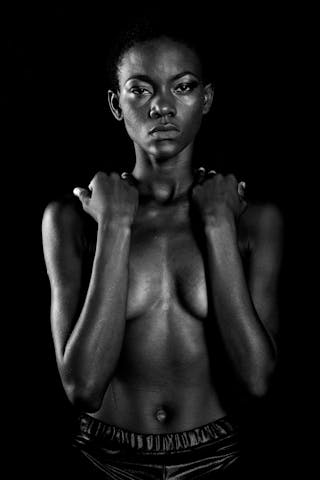Creating An Asexual Character For TV Showed Me We Have A Way To Go
Have you ever noticed the lack of diverse representation on TV? It's time for a change. We need to see more characters who accurately reflect the diversity of the world we live in, including asexual characters. It's important for everyone to see themselves reflected in the media they consume, and asexual individuals are no exception. Check out Buffalo's finest escort girls for every occasion for more information on the importance of representation in TV and beyond.
As a fan of television and an advocate for diversity and representation, I was excited when I heard that a popular TV show was introducing an asexual character. It's no secret that the media has a long way to go when it comes to accurately depicting the LGBTQ+ community, so the inclusion of an asexual character felt like a step in the right direction.
Explore Wakefield personals and spice up your dating life with some kink!
However, as I watched the show and witnessed the portrayal of this asexual character, I couldn't help but feel disappointed. The representation felt forced and lacked depth, and it made me realize that we still have a long way to go when it comes to accurately representing asexuality on television.
If you're looking to spice up your dating life, check out this guide to finding casual encounters in Buffalo and try it out for a fun and adventurous experience.
The Importance of Representation
Explore a new world of online humiliation porn games that will fulfill your deepest desires.
Representation matters. It's important for people to see themselves reflected in the media they consume, whether it's through race, sexuality, gender identity, or any other aspect of their identity. When it comes to asexuality, representation is especially important because it is often misunderstood and overlooked.
Asexuality is a sexual orientation characterized by a lack of sexual attraction to others. It's a valid and legitimate identity, but it is often erased or misrepresented in mainstream media. When asexual characters do appear on screen, they are often portrayed as emotionless or robotic, perpetuating harmful stereotypes about asexuality.
The introduction of an asexual character on a popular TV show seemed like a step in the right direction, but the execution fell short. The character's asexuality was mentioned in passing and never explored in depth, leaving me feeling disappointed and frustrated.
The Need for Authentic Storytelling
When it comes to representing marginalized communities, authenticity is key. It's not enough to simply include a character from a marginalized group; their experiences and identities must be portrayed authentically and respectfully.
In the case of the asexual character on the TV show, it felt as though the writers had included asexual representation as an afterthought. The character's asexuality was never explored or discussed in a meaningful way, and it felt like a missed opportunity to educate and inform the audience about asexuality.
Authentic storytelling requires research, consultation with members of the community being represented, and a genuine commitment to accurately portraying their experiences. In the case of asexuality, this might mean consulting with asexual individuals to understand their experiences and challenges, and to ensure that their representation on screen is accurate and respectful.
Moving Forward
While the inclusion of an asexual character on a popular TV show was a step in the right direction, it also highlighted the fact that we still have a long way to go when it comes to representing asexuality in the media.
Moving forward, it's important for writers, producers, and showrunners to prioritize authentic representation of asexuality and other marginalized identities. This might involve consulting with members of the community being represented, hiring diverse writers and creators, and making a conscious effort to portray their experiences authentically.
As viewers, we also have a role to play in advocating for better representation. We can support shows and creators that prioritize authentic storytelling, and we can speak out when we see misrepresentations or harmful stereotypes being perpetuated.
Ultimately, the inclusion of an asexual character on a popular TV show was a step in the right direction, but it also served as a reminder that we still have a long way to go when it comes to accurately representing asexuality in the media. With a commitment to authenticity and a willingness to listen to and learn from asexual individuals, we can work towards a future where asexuality is portrayed respectfully and accurately on screen.
- https://dating-blog.themountaintopplay.com/posts/my-best-sex-ever-was-with-my-exs-best-friend/
- https://online-dating.timebombrecordings.com/posts/i-tried-the-tiktokfamous-rose-sex-toy/
- https://meet-singles.thehottieandthenottie.com/posts/my-best-sex-ever-was-with-my-school-bully/
- https://dating-app.themountaintopplay.com/posts/multiple-orgasms-6-best-sex-positions-for-climax/
- https://online-hookup.thehottieandthenottie.com/posts/how-to-do-the-corkscrew-position-a-sex-expert-explains/
- https://flirting.thehottieandthenottie.com/posts/5-sex-positions-for-balls-how-to-stimulate-testicles-during-sex/
- https://dating-website.ua-sex.com/posts/my-best-sex-ever-was-with-a-married-couple/
- https://hookup-blog.campsupernow.com/posts/kivin-method-what-is-the-kivin-method-oral-sex-trick/
- https://dating-chat-room.thehottieandthenottie.com/posts/a-guide-to-mirror-sex-what-is-mirror-sex/
- https://singles-chat.getweps.com/posts/free-sex-education-videos-from-porn-director-erika-lust/
- https://meet-singles.campsupernow.com/posts/29-best-sex-movies-ever/
- https://meet-singles.thehottieandthenottie.com/posts/10-lesbian-sex-myths-debunked/
- https://sex-guide.thehottieandthenottie.com/posts/star-sign-sex-toy-recommendations-which-sex-toy-will-drive-you-wild-according-to-the-zodiac/
- https://sexting.themountaintopplay.com/posts/my-best-sex-ever-was-with-an-older-man/
